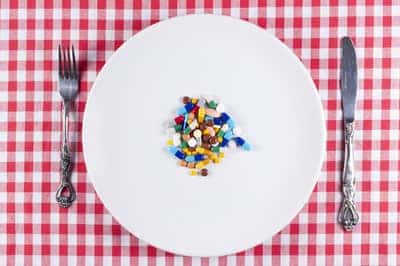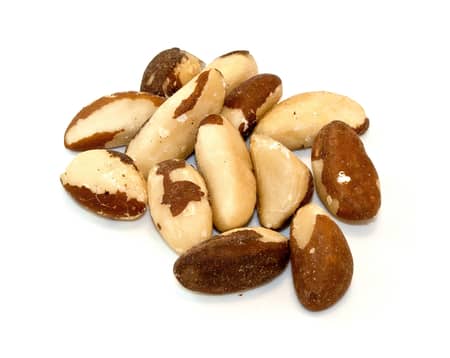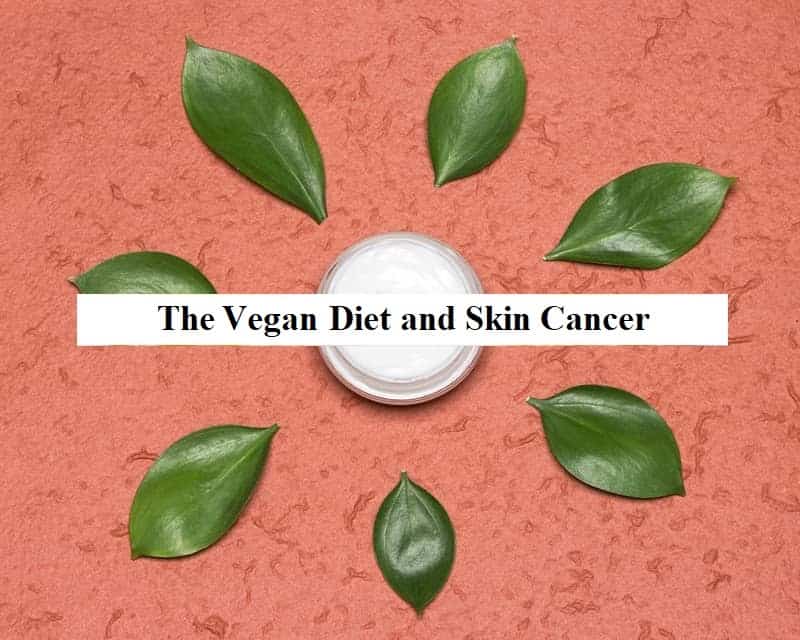Does
The short answer is that, unfortunately, there isn’t enough data to draw any conclusions at this point. Most studies, meta-analyses, and systematic reviews looking at cancer rates in vegetarian groups exclude nonmelanoma skin cancers (NMSC).
It’s just not a big area of inquiry—despite NMSC being the most common cancer among Americans.1
Anyway, while there haven’t been many epidemiological studies investigating vegan skin cancer outcomes (none dedicated to this topic that I’m aware of), there are many aspects of a healthy whole food vegan diet that are considered protective against the development of skin cancer. Below, I’ll list certain aspects that are, indeed, helpful.
Antioxidants
Whatever the role of diet, ultraviolet (UV) radiation exposure is the number one risk factor for the development of NMSC.
Helpful dietary components come into play in that they may help mitigate damage from UV radiation—after all, no one can avoid sun damage all together.
Dietary antioxidants (AOs) can prevent free radical-mediated damage to DNA and thus tumorigenesis due to UV radiation.
Not all dietary AOs are equal in this respect—in part because some AOs are more plentiful in the skin than others. Numerous lab studies have found certain AOs found in plant foods to show significant promise in the prevention of skin cancer.
As for human studies, researchers have looked at both dietary intake of OAs (in whole food form) and oral AO supplementation.
What I’ll do from here is zero in on a few specific dietary AOs that are thought to be protective against skin cancer, and compare the benefits of acquiring these nutrients in whole food vs. pill form. Hint: whole foods win overall.
Whole Food vs. Pills

Some studies have been carried out to test the efficacy of isolated beta-carotene in preventing UV-induced DNA damage. Researchers were surprised to find that not only did beta-carotene supplementation fail to provide any benefits in preventing UV radiation, it actually caused a significant exacerbation of UV carcinogenic expression.2
Other studies have focused on “combined consumption of foods” as opposed to isolated nutrients. One study by Ibiebele T. I., et al. found fruit and vegetable intake to decrease NMSC compared to a dietary pattern characterized by meat and fat intake.3
However, some AOs such as vitamins C, E, and AOs in green tea have shown some efficacy in preventing UV-induced DNA damage when applied topically or taken in pill form.
Several animal studies have found isolated AOs to provide protection against skin cancer. For example, hairless mice exposed to UV light experienced a significant reduction in the incidence of malignant lesions after receiving supplemental vitamin C in the diet.4
More on vitamin C in a bit.
The Role of Antioxidants in Preventing Skin Cancer
As with other cancers, NMSC tumorigenesis is a multistage process, made up of three phases: initiation, promotion, and progression.
AOs come in to play in what would be the initiation process, because free radical-induced damage is known to play a significant role in the initiation phase.5
As you might have guessed, free radical damage is known to be caused in part by UV radiation. Exposure to environmental pollutants is also thought to play a role.
Free radicals are what we call molecules having unpaired electrons. These little molecules cause direct damage to to proteins, DNA, and lipids. Most free radicals in our body exist as reactive oxygen species (ROS).5
Not to get too science-y, but ROS cause damage to the bases and deoxyribosyl backbone of DNA molecules.6,7
This damage to DNA can lead to tumorigenesis—of the skin in this case. I also just mentioned damage to other cellular proteins caused by free radicals. When enzymes (little proteins) are oxidized it can activate pathways that produce new proteins, which can increase cancer cell proliferation.8
Also, UV radiation cause immunosuppression, which hampers the ability of immune cells to recognize and thus fight cancer cells.9
As tumor formation progresses, other accompanying changes can result in an increased capacity for tumor cell invasion and metastasis.10
AOs help combat these initiation and progression processes through several mechanisms that prevent oxidative reactions and DNA damage.11
Doesn’t the Skin Have Its Own Antioxidants? Why Do We Need Antioxidants from Food?
True, there are many OAs naturally present in the skin, found in varying amounts from the epidermis to the dermis.12
These innate skin AOs include enzymes such as glutathione peroxidase, superoxide dismutase.5,13
But, these innate antioxidants can use all the help they can get. While the body has its own mechanisms to neutralize ROS, UV exposure can cause oxidative stress to accumulate to the point where these innate defenses become overwhelmed.
It’s for this reason that researchers have turned to exploring the benefits of exogenous AOs in reducing UV-induced carcinogenesis.14
Like I said above, what we’ll do here is explore a few specific AOs that are thought to protect against skin cancer.
Carotenoids
Carotenoids are the yellow, orange, and red pigments found in abundance throughout the plant kingdom. Think pumpkins, squash, tomatoes, etc. They’re also highly present in greens, it’s just that other pigments are more dominant in these food groups.
Hundreds of carotenoids exist, and it’s said that about 40 or so are present in the typical human diet.15
Of the 40 present in the human diet, beta-carotene gets the most attention. Beta-carotene is the orange pigment present in sweet potatoes and pumpkins. Not only is it the most well-known, but it’s also the most studied due to the fact that it’s the most commonly consumed.
In both lab and animal studies, carotenoids have been shown influence carcinogenesis, and there are several explanations that try to account for the effect:
- For one, carotenoids can be converted to retinoids in the body, which have been shown to suppress carcinogenesis in several animal models.16
- Another explanation focuses on the AO properties of carotenoids, as the molecules have been shown to scavenge free radicals.17 This mechanism was found to be independent of retinoid activity.18
- The oxidation of lipids is also thought to play a role in ROS pathways of tumor development. In animal studies anyway, beta-carotene has been shown to suppress lipid peroxidation.19,20
Green Tea Phytochemicals
If you’ve read my articles on the vegan diet, longevity and anti-aging, then you know that many antioxidants present in green tea have been shown to have anti-cancer properties.
Drinking green tea may help prevent the development of a number cancers.21

Not only has EGCG been shown to potentially prevent cancers of the breast and prostate, it’s also been shown to suppress the proliferation of melanoma.22
Even isolated EGCG may offer some protection. Doses of EGCG ten times higher than what you can get by drinking tea inhibits a number of molecules involved in cancer cell signaling pathways.22
How Do They Work?
For one, EGCG binds to DNA and RNA, where it may act to protect these molecules from UV light, as well as ROS-induced damage, ionizing radiation, and methylation.23,24
The compounds in green tea thus result in molecular changes that can inhibit cancer pathways.25
Vitamin E
Vitamin E is a fat-soluble vitamin that actually represents a group of 8 closely related molecules (what are known as isomers in organic chemistry). These 8 molecules include 4 “tocopherols” and 4 “tocotrienols” (I guess all the good names were taken).26
The naturally occurring form of vitamin E, the D-alpha tocopherol isomer has the greatest biological activity.
Like EGCG and vitamin C, vitamin E is a molecule that’s shown some efficacy in preventing skin cancer when taken in isolated form, which is why it’s often included in sunscreens. (You’ll, of course, want to make sure that you consume ample amounts of vitamin E-rich food sources for best results. It’s found in nuts, seeds, wheat germ, and soybeans).
In one study researchers exposed mice to a topical carcinogen, and supplementation with vitamin E reduced the number of tumors by 25%.27
How Does It Work?
It’s been shown to prevent ROS-induced oxidation of lipids in our cell membranes.
In one animal study looking at the skin cells of mice, vitamin E treatment administered prior to UVB radiation was shown to reduce epidermal damage.28
In human skin cells exposed to UVA light, vitamin E was shown to be photoprotective.29
Vitamin C
Ascorbic acid (vitamin C), is a water-soluble vitamin found abundantly in fruits and vegetables. It serves several functions in the body, namely as a cofactor of multiple enzymes in the human body (lysyl hydroxylase and prolyl – not important).11
Sure, it’s used in collagen synthesis, but vitamin C also serves as an intracellular antioxidant. In numerous studies vitamin C has been shown to be protective against carcinogenesis via UV radiation. In one study of cultured keratinocytes (skin cells that produce keratin), researchers found vitamins C to counteract UVB irradiation-induced ROS, and protect against UVB-induced cell death.30
If you read my article on anti-aging and skin health, you know that the dermis (deeper layers of the skin) contain collagen which can be damaged by UV radiation. Vitamin C can help damaged dermal DNA repair from UV-induced insult. It seems to increase expression of genes associated with DNA repair and replication.31
Selenium

If you’ve ever taken skin, hair and nail supplements you probably noticed that selenium is usually included. Selenium is a trace mineral (a mineral needed in tiny amounts) that’s found in numerous food sources and serves as an antioxidant.
Granted, you can find the stuff in many animal products, but plant foods—namely, Brazil nuts—contain the mineral in extremely high amounts.
Proteins that contain amino acids with selenium are called selenoproteins, and these proteins are found abundantly in the skin.
Some studies have shown that mice lacking selenoproteins do develop skin abnormalities.32
In another study of mice, dietary selenium supplementation prior to and during UV radiation was shown to provide significant protection against skin cancer.33
Some studies have shown selenium to be anti-carcinogenic, inducing death in skin cancer cells.34
In another study of mice, a selenium compound reduced skin lesions, and cell proliferation.35
How Does It Work?
Well, ROS generation has been implicated as part of the mechanism responsible for UVB-radiation-induced skin damage.
We’ve talked about UV-induced ROS damage to skin cells. Well, ROS induced by UVB radiation specifically has been implicated in cell damage that leads to skin cancer.
In mice anyway, evidence seems to suggest that increased selenium intake may protect skin from much of the harmful effects of UVB radiation.41
This led researchers to try to determine the selenoprotein profile of cultured human skin cells and whether or not selenium supplementation could protect various types of skin cells from the effects of UVB radiation.
Labelling experiments showed both qualitative and quantitative differences in selenoprotein expression by human each of the skin cell types tested.
Researcheres found that a 24 hours preincubation with various Se compounds protected both melanocytes and keratinocytes from UVB-induced cell death.
Protection could be achieved even when selenium was added after UVB radiation, with cell death being reduced from 88.5% to 50%.
It should be noted that this is highly theoretical at this point. No one knows for sure whether selenium intake from food (or supplements for that matter) helps prevent skin cancer. But, it definitely looks promising.
But, many studies have shown death rates from certain cancers such as NMSC, lung, and colon cancers to be lower in people with both higher intakes of selenium and higher levels of selenium in the blood.
Soy Products
Genistein is a highly studied isoflavone found in soybeans and soy products.
Asian diet are full of soy foods and, as a result, Asian populations consume high levels of genistein.21
Well, what about skin cancer specifically?
Genistein protects melanocytes from UV radiation-induced melanoma and has been shown to reduce melanoma incidence.36
How Do They Work?
Well, the skin has natural defense mechanisms against sun damage. One of which being that it stimulates the production of melanin. At least part of the effect of Genistein is to initiate this process.36
Genistein is also able to arrest cell growth and proliferation, and suppress tumor cell invasion.36,37
Finally, genistein seems to improve immune function which, of course, helps your body recognize and fight cancer cells. It does this by altering gene expression of certain antigens which helps facilitate recognition of immune cells.
It also acts synergistically with a number of other molecules—including flavonoids and green tea catechins which I talk about in the articles on longevity and anti-aging.36
Calorie Restriction
Finally, we have calorie restriction. As mentioned in the articles on longevity, calorie restriction seems to offer quite a few benefits when it comes to preventing chronic disease. It may help with skin cancer, specifically.
What’s this have to do with the vegan diet? Well, low-fat plant-based diets tend to result in spontaneous calorie restriction—i.e. calorie restriction that’s not pre-planned. This spontaneous restriction can result in as much as a 11-31% calorie deficit. This is thought to be mostly due to lower calorie density—i.e. the higher fiber, lower fat composition of plant-based diets.38,39
How Does It Work?
There may be more than one mechanism by which calorie restriction helps prevent cancer—some that involve the initiation, promotion, and progression phases.
As for skin cancer, glucocorticoids may be involved. Caloric restriction affects blood levels of glucocorticoids, a hormone that seems to play a major role in inhibiting skin carcinogenesis.40
Anyway, that wraps it up for now. Prior to looking into this a few years back, I wasn’t aware that had anything to do with skin cancer development. Keep eating your fruits and veggies, and always wear sunscreen.
References
- Venura Samarasinghe and Vishal Madan. Nonmelanoma Skin Cancer. J Cutan Aesthet Surg. 2012;5(1): 3–10.
- Black H. S., Gerguis J. Modulation of dietary vitamins E and C fails to ameliorate β-carotene exacerbation of UV carcinogenesis in mice. Nutrition and Cancer. 2003;45(1):36–45.
- Ibiebele T. I., van der Pols J. C., Hughes M. C., Marks G. C., Williams G. M., Green A. C. Dietary pattern in association with squamous cell carcinoma of the skin: a prospective study. American Journal of Clinical Nutrition. 2007;85(5):1401–1408.
- Pauling L., Willoughby R., Reynolds R., Blaisdell B. E., Lawson S. Incidence of squamous cell carcinoma in hairless mice irradiated with ultraviolet light in relation to intake of ascorbic acid (vitamin C) and of D, L-alpha-tocopheryl acetate (vitamin E) International Journal for Vitamin and Nutrition Research Supplement. 1982;23:53–82
- Chen L., Hu J. Y., Wang S. Q. The role of antioxidants in photoprotection: a critical review. Journal of the American Academy of Dermatology. 2012;67(5):1013–1024.
- Valko M., Izakovic M., Mazur M., Rhodes C. J., Telser J. Role of oxygen radicals in DNA damage and cancer incidence. Molecular and Cellular Biochemistry. 2004;266(1-2):37–56.
- Cadet J., Douki T. Oxidatively generated damage to DNA by UVA radiation in cells and human skin. Journal of Investigative Dermatology. 2011;131(5):1005–1007.
- Bickers D. R., Athar M. Oxidative stress in the pathogenesis of skin disease. Journal of Investigative Dermatology. 2006;126(12):2565–2575.
- Hart PH and Norval M. Ultraviolet radiation-induced immunosuppression and its relevance for skin carcinogenesis. Photochem Photobiol Sci. 2018;5;17(12):1872-1884.
- Camp W. L., Turnham J. W., Athar M., Elmets C. A. New agents for prevention of ultraviolet-induced nonmelanoma skin cancer. Seminars in Cutaneous Medicine and Surgery. 2011;30(1):6–13.
- Cadenas E., Packer L. Handbook of Antioxidants. 2nd. New York, NY, USA: Marcel Dekker; 2002.
- Shindo Y., Witt E., Han D., Epstein W., Packer L. Enzymic and non-enzymic antioxidants in epidermis and dermis of human skin. Journal of Investigative Dermatology. 1994;102(1):122–124.
- Godic A., Poljšak B., Adamic M., Dahmane R. The role of antioxidants in skin cancer prevention and treatment. Oxidative Medicine and Cellular Longevity. 2014;2014:6.
- De Almendra Freitas B. E., De Castro L. L., Aguiar J. R. S., et al. Antioxidant capacity total in non-melanoma skin cancer and its relationship with food consumption of antioxidant nutrients. Nutrición Hospitalaria. 2015;31(4):1682–1688.
- Paiva S. A. R., Russell R. M. β-Carotene and other carotenoids as antioxidants. Journal of the American College of Nutrition. 1999;18(5):426–433.
- Alizadeh F., Bolhassani A., Khavari A., Bathaie S. Z., Naji T., Bidgoli S. A. Retinoids and their biological effects against cancer. International Immunopharmacology. 2014;18(1):43–49.
- Martin K. R., Failla M. L., Smith J. C., Jr. Beta-carotene and lutein protect HepG2 human liver cells against oxidant-induced damage. Journal of Nutrition. 1996;126(9):2098–2106.
- Lomnitski L., Grossman S., Bergman M., Sofer Y., Sklan D. In vitro and in vivo effects of β-carotene on rat epidermal lipoxygenases. International Journal for Vitamin and Nutrition Research. 1997;67(6):407–414.
- Iyama T., Takasuga A., Azuma M. β-Carotene accumulation in mouse tissues and a protective role against lipid peroxidation. International Journal for Vitamin and Nutrition Research. 1996;66(4):301–305.
- Zwald F. O., Brown M. Skin cancer in solid organ transplant recipients: advances in therapy and management: part II. Management of skin cancer in solid organ transplant recipients. Journal of the American Academy of Dermatology. 2011;65(2):263–279.
- Park, O. J. and Surh, Y. J., 2004. Chemopreventive potential of epigallocatechin gallate and genistein: evidence from epidemiological and laboratory studies. Toxicol Lett 150, 43–56.
- Lambert, J. D. and Yang, C. S., 2003. Mechanisms of cancer prevention by tea constituents. J Nutr 133, 3262–3267.
- Kuzuhara, T., Sei, Y., Yamaguchi, K., Suganuma, M. and Fujiki, H., 2006. DNA and RNA as new binding targets of green tea catechins. J Biol Chem 281, 17446–17456.
- Fang, M. Z., Wang, Y., Ai, N., Hou, Z., Sun, Y., Lu, H., Welsh, W. and Yang, C. S., 2003. Tea polyphenol (–)-epigallocatechin-3-gallate inhibits DNA methyltransferase and reactivates methylation-silenced genes in cancer cell lines. Cancer Res 63, 7563–7570.
- Fujiki, H., 2005. Green tea: health benefits as cancer preventive for humans. Chem Rec 5, 119–132.
- Treloar V. Chemoprevention and vitamin E. Journal of the American Academy of Dermatology. 2007;57(5):p. 903.
- Lambert L. A., Wamer W. G., Wei R. R., Lavu S., Chirtel S. J., Kornhauser A. The protective but nonsynergistic effect of dietary β-carotene and vitamin E on skin tumorigenesis in Skh mice. Nutrition and Cancer. 1994;21(1):1–12.
- Maalouf S., El-Sabban M., Darwiche N., Gali-Muhtasib H. Protective effect of vitamin E on ultraviolet B light-induced damage in keratinocytes. Molecular Carcinogenesis. 2002;34(3):121–130.
- Offord E. A., Gautier J.-C., Avanti O., et al. Photoprotective potential of lycopene, β-carotene, vitamin E, vitamin C and carnosic acid in UVA-irradiated human skin fibroblasts. Free Radical Biology and Medicine. 2002;32(12):1293–1303.
- Jin G.-H., Liu Y., Jin S.-Z., Liu X.-D., Liu S.-Z. UVB induced oxidative stress in human keratinocytes and protective effect of antioxidant agents. Radiation and Environmental Biophysics. 2007;46(1):61–68.
- Duarte T. L., Cooke M. S., Jones G. D. D. Gene expression profiling reveals new protective roles for vitamin C in human skin cells. Free Radical Biology and Medicine. 2009;46(1):78–87.
- Sengupta A., Lichti U. F., Carlson B. A., et al. Selenoproteins are essential for proper keratinocyte function and skin development. PLoS ONE. 2010;5(8)
- Overvad K., Thorling E. B., Bjerring P., Ebbesen P. Selenium inhibits UV-light-induced skin carcinogenesis in hairless mice. Cancer Letters. 1985;27(2):163–170.
- Jariwalla R. J., Gangapurkar B., Nakamura D. Differential sensitivity of various human tumour-derived cell types to apoptosis by organic derivatives of selenium. British Journal of Nutrition. 2009;101(2):182–189.
- Das R. K., Hossain S. K. U., Bhattacharya S. Diphenylmethyl selenocyanate inhibits DMBA-croton oil induced two-stage mouse skin carcinogenesis by inducing apoptosis and inhibiting cutaneous cell proliferation. Cancer Letters. 2005;230(1):90–101.
- Ravindranath, M. H., Muthugounder, S., Presser, N. and Viswanathan, S., 2004. Anticancer therapeutic potential of soy isoflavone, genistein. Adv Exp Med Biol 546, 121–165.
- Sarkar, F. H. and Li, Y., 2002. Mechanisms of cancer chemoprevention by soy isoflavone genistein. Cancer Metastasis Rev 21, 265–280.
- Bray G. A., Popkin B. M. Dietary fat intake does affect obesity. American Journal of Clinical Nutrition. 1998;68(6):1157–1173.
- Rolls B. J. The role of energy density in the overconsumption of fat. Journal of Nutrition. 2000;130(2):268S–271S
- Birt, D. F., Przybyszewski, J., Wang, W., Stewart, J. and Liu, Y., 2004. Identification of molecular targets for dietary energy restriction prevention of skin carcinogenesis: an idea cultivated by Edward Bresnick. J Cell Biochem 91, 258–264.
- Rafferty, T.S., McKenzie, R.C., Hunter, J.A.A., Howie, A.F., Arthur, J.R., Nicol, F., and Beckett, G.J. Differential expression of selenoproteins by human skin cells and protection by selenium from UVB-radiation-induced cell death. Biochem. J., 332, 231, 1998.


